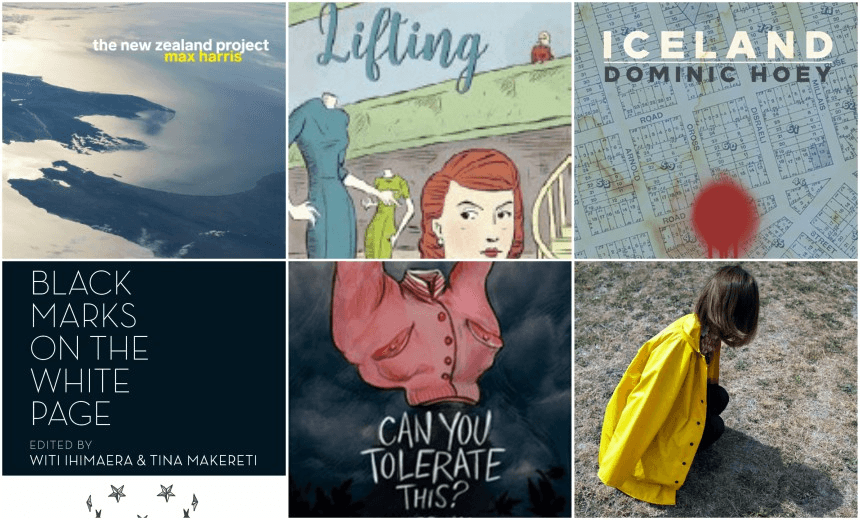A special investigation headed by Steve Braunias asks: Has much happened this year in New Zealand writing?
Nothing much has happened this year in New Zealand writing. It’s been pretty quiet. No new sensation, like Hera Lindsay Bird in 2016; a lot of stuff from Victoria University Press, some of it readable; trash from the mainstream publishers; an exciting anthology; and quite a bit of really good, really interesting work published on the outskirts of town.
FICTION
A good book
Is Iceland, the debut novel by Dominic Hoey, the outstanding New Zealand novel of 2017? The nimble independent publisher Steele Roberts brought it out with very little fanfare but the book has caught on, especially in Auckland. Hoey’s book is set in Grey Lynn, and follows the goings-on of characters on the dole, characters on the game, characters on the needle. It’s kind of renegade literature – Hoey is outside of the whole excruciating IIML establishment, and performs slam poetry for his sins – and his book has an energy conspicuously absent in much New Zealand fiction.
Zzzzz
VUP came out with things by Pip Adam and Tim Corballis. Penguin came out with a new novel about youth suicide by Sarah Quigley; reviewers dug a hole, and buried it as deeply as they could.
Some other good books
Mandy Hager wrote a popular historical novel, Heloise. “Genius,” said our reviewer Linda Burgess, of Lifting by Damien Wilkins. But the most exciting work of fiction published this year has been Black Marks on The White Page, a new anthology of Māori and Pasifika writing; does it signal a new age, a renaissance, in Māori and Pasifika literature? Gee who knows eh but it’s worth mentioning that the most adventurous, most ebullient book of New Zealand verse of 2017 is about to be published any day now (August 21) by Auckland University Press: Tightrope, by Selina Tusitala Marsh.
The future
The year’s most eagerly awaited novel is about to be published any day now – Decline and Fall on Savage Street, by Christchurch writer Fiona Farrell.
NON-FICTION
A good book
The smash non-fiction hit of the year has been by The New Zealand Project, by Max Harris. The dude is even going on a nationwide lecture tour – a New Zealand author, on a nationwide lecture tour! – to further discuss his “vision for confronting the challenges ahead.” Bravo to Max and bravo, too, to his inventive and increasingly important publisher, Bridget Williams Books, which is specialising in slim, perfectly formed essays and memoirs, and is surely a contender to win publisher of the year at the booksellers conference in August.
Some other good books
Bridget Williams could very easily dominate the general non-fiction field at the 2018 Ockham New Zealand Book Awards. As well as the Harris book, it published Scott Hamilton’s Pacific tragedy The Stolen Island, Holly Walker’s best-seller The Whole Intimate Mess, and Emma Ng’s thoughtful Old Asian, New Asian; they will, however, have to compete with my boisterous road trip The Man Who Ate Lincoln Road (Luncheon Sausage Books).
Some trash
The fizzer of the year has been Hit & Run, the Hager-Stephenson inquiry which raced to the top of the best-seller list and then raced back down again when the authors made a long-winded, bewildering job of addressing something which may or may not have been a significant factual mistake. There’s been good trash, such as Miriam Lancewood’s Woman in the Wilderness, a pretty extreme memoir of the author’s experience in the wild; and just plain fucking trash, from Penguin, publishers of psychic Kevin Cruickshank’s Surrounded by Spirit, more widely known as Surrounded by Bullshit.
The future
I have read a proof copy of Diana Wichtel’s family memoir Driving to Treblinka: The long search for a lost father, due to be published by Awa Press, and can calmly assess it as the best piece of writing in New Zealand in 2017.
GENERAL REMARKS
Money
The feel-good New Zealand literature story of the year was the one about Wellington writer Ashleigh Young, who picked up the phone one day and discovered she was $229,837.07 richer, as winner of a Windham-Campbell Award at Yale University. It couldn’t have happened to a more blazingly original essayist.
More money
Congratulations are also due to Morgan Godfrey. He has been awarded $28,000 to work on a history of dissent in New Zealand – for Bridget Williams Books, naturally. Okay so it’s mildly ironic that he got state money to write about the smashing of the state but not that ironic that anyone should have a problem with it, this isn’t Twitter you know.
Money, continued
Haw but what about Dr Philip Norman! The dude got $100,000 as winner of the Michael King Writers Fellowship to write a history of New Zealand composers – a book which has occupied him for quite some time, it would appear, because he was awarded $35,000 via a Copyright Licensing Limited writers award in 2008 to “work on a general history of New Zealand composition”. Will he pick up a third cheque before completing the book?
The future
As well as Diana Wichtel’s compelling memoir, and Fiona Farrell’s novel “set in a city devastated by major earthquakes”, New Zealand titles to look out for in the next few months include a new novel by CK Stead, a true-crime book by Herald journalist and 2016 Surrey Hotel writers residency award winner Kelly Dennett (NB: the shortlist for this year’s Ngaio Awards for crime fiction and true-crime is announced in August), a major anthology of investigative journalism published by Massey University Press (partly redeeming their work on the year’s most boring book, the essay collection Home), and, most spectacularly of all, the coffee table pictorial book The New Zealand Cat. We have assigned New Zealand’s greatest cat writer to cover this modern masterpiece at length in the dear old Spinoff Review of Books.
The Spinoff Review of Books is brought to you by Unity Books.

